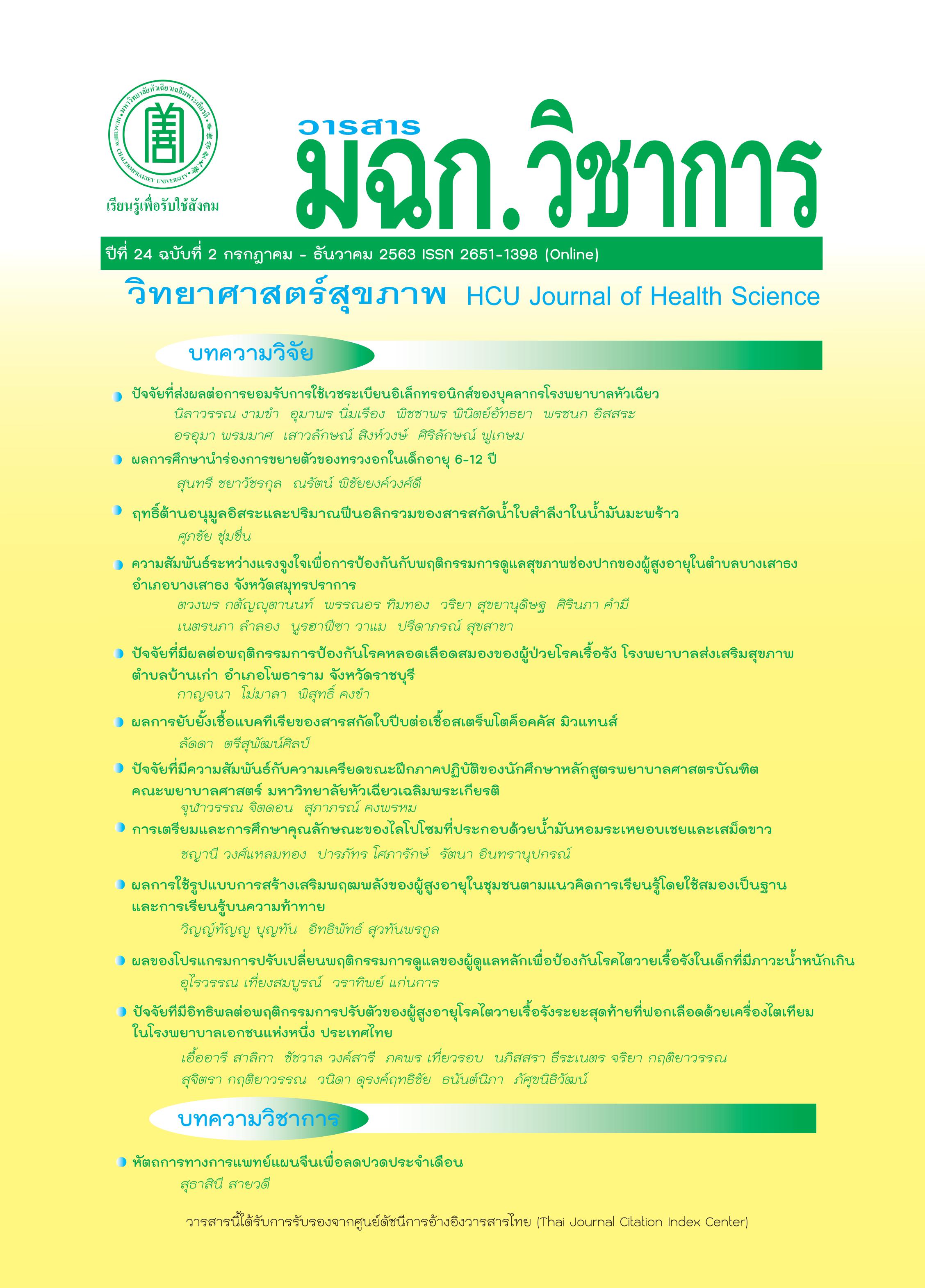Preparation and Characterization of Liposomes Containing Cinnamon and Cajuput Essential Oils
Keywords:
liposomes, cinnamon oil, cajuput oil, encapsulation efficiency, GC-MSAbstract
Abstract
The aim of the study was to prepare liposomes entrapping essential oils in order to decrease volatility and enhance stability. The combination of cinnamon (Cinnamomum burmanii) and cajuput (Melaleuca Leucadendron) oils (1:1 by volume) was selected for incorporation into liposome and was analyzed by a developed gas chromatography-mass spectrometry (GC-MS) method for two major compounds, cinnamaldehyde and eucalyptol. The liposomal formulations composed of phospholipid, cholesterol and oils mixture (2 mg/mL) were prepared using a thin film hydration method. The effects of different mass ratios of phospholipid/cholesterol (60:40, 70:30, 80:20, 90:10) and sonication time (0, 2 and 5 minutes) on oil entrapment efficiency were evaluated. The optimized formulation, containing the mass of phospholipid to cholesterol ratio of 80:20 and generated via sonication for 2 minutes, emerged the maximum amount of the two major components (88.40±0.22%) and was used for further preliminary stability studies at 4+2ºC and the room temperature, 25+2ºC, for a period of 2 months. Results showed that the essential oils in liposomal formulation were quite stable within 2 months at both storage temperatures and had good physical appearance. The percentage of oil retention in the liposomal formulations decreased by 8.78 and 12.83 at both temperatures, respectively. Findings suggested that the combination of cinnamon and cajuput oils which enhance antiacne-inducing bacterial activities and are stabilized in the liposomal formulation could be further developed to provide the anti-acne cosmetic products.
Downloads
References
Chouhan S, Sharma K, Guleria S. Antimicrobial activity of some essential oils - present status and future perspectives. Medicines. 2017;4(3):58-78.
Da Silvai GL, Luft C, Lunardelli A, Amaral RH, Melo DA, Donadio MV, et al. Antioxidant, analgesic and anti-inflammatory effects of lavender essential oil. An Acad Bras Cienc. 2015;87(2)(Suppl.):1397-408.
Sarmento-Neto JF, Do Nascimento LG, Felipe CF, De Sousa DP. Analgesic potential of essential oils. Molecules. 2016;21(1):20-48.
Rabbani M, Sajjadi SE, Sadeghi M. Chemical composition of the essential oil from Kelussia odoratissima Mozaff. and the evaluation of its sedative and anxiolytic effects in mice. Clinics. 2011;66(5):843-8.
Tsuchiya H. Anesthetic agents of plant origin: a review of phytochemicals with anesthetic activity. Molecules. 2017;22(8):1369-403.
Bhavaniramya S, Vishnupriya S, Al-Aboody MS, Vijayakumar R, Baskaran D. Role of essential oils in food safety: antimicrobial and antioxidant applications. Grain Oil Sci Technol. 2019;2:49-55.
Turek C, Stintzing FC. Stability of essential oils: a review. Compr Rev Food Sci Food Saf. 2013;12:40-53.
Sherry M, Charcosset C, Fessi H, Greige-Gerges H. Essential oils encapsulated in liposomes: a review. Liposome Res. 2013;23(4):268-75.
Bulbake U, Doppalapudi S, Kommineni N, Khan W. Liposomal formulations in clinical use: an updated review. Pharmaceutics. 2017;9,12-44.
Bassolé IHN, Juliani HR. Essential oils in combination and their antimicrobial properties. Molecules. 2012;17:3989-4006.
Wonglamthong C, Indranupakorn R, Rattanaroatpong T, et al. Study of antioxidant and anti-acne inducing bacterial activities of cinnamon, cajuput and plai essential oils. Agricultural Sci J. 2016;47(2)(Suppl.):141-4.
Liolios CC, Gortzi O, Lalas S, Tsaknis J, Chinou I. Liposome incorporation of carvacrol and thymol isolated from the essential oil of Origanum dictamnus L. and in vitro antimicrobial activity. Food Chem. 2009;112:77-83.
Pasha K, Banu S. Formulation and evaluation of glimepiride liposomal drug delivery system. IJRBS. 2017;4(3):39-44.
Zhang J, Froelich A, Michniak-Kohn B. Topical delivery of meloxicam using liposome and microemulsion formulation approaches. Pharmaceutics. 2020;12(3):282-305.
ICH Expert Working group. Validation of Analytical Procedures: Text and Methodology Q2(R1), ICH Harmonised Tripartite guidelines. International Conference on Harmonisation of Technical Requirements for Registration of Pharmaceuticals for Human Use. [internet]. 2005 [Cited 2020 Oct 22];1-15. Available from database.ich.org/sites/default/files/Q2%28R1%29%20guideline.pdf.
Peng C, Zhang T, Zhao G, Wang S. Analysis on fat-soluble components of Sinapis semina from different habitats by GC-MS. J Pharm Anal. 2013;3(6),402-7.
Yusaf R, Nawaz R, Hayat S, Khursheed A, Zafar N, Ahmad, A, et al. Structural components of liposomes and characterization tools. Indo Am j Pharm. 2014;4(8),3559-67.
Kirby C, Clarke J, Gregoriadis G. Effect of the cholesterol content of small unilamellar liposomes on their stability in vivo and in vitro. Biochem J. 1980;186(2):591-8.
Shilakari Asthana G, Asthana A, Singh D, Sharma PK. Etodolac containing topical niosomal gel: Formulation development and evaluation. J Drug Deliv. [internet]. 2016 [Cited 2020 Oct 22]; 9324567. Available from https://pubmed.ncbi.nlm.nih.gov/27478643/. Doi:10.1155/2016/9324567.
Nam JH, Kim SY, Seong H. Investigation on physicochemical characteristics of a nanoliposome-based system for dual drug delivery. Nanoscale Res Lett. [internet]. 2018 [cited 2020 Oct 22]; 13(1):101. Available from https://pubmed.ncbi.nlm.nih.gov/29654484/. Doi:10.1186/s11671-018-2519-0.
Chen M, Liu X, Fahr A. Skin penetration and deposition of carboxyfluorescein and temoporfin from different lipid vesicular systems: In vitro study with finite and infinite dosage application. Int. J. Pharm. 2011;408(1-2),223–34.
Downloads
Published
How to Cite
Issue
Section
License
บทความที่ได้รับการตีพิมพ์เป็นลิขสิทธิ์ของวารสารวิทยาศาสตร์สุขภาพและสุขภาวะ
ข้อความที่ปรากฏในบทความแต่ละเรื่องในวารสารวิชาการเล่มนี้เป็นความคิดเห็นส่วนตัวของผู้เขียนแต่ละท่านไม่เกี่ยวข้องกับมหาวิทยาลัยหัวเฉียวเฉลิมพระเกียรติ และคณาจารย์ท่านอื่นๆในมหาวิทยาลัยฯ แต่อย่างใด ความรับผิดชอบองค์ประกอบทั้งหมดของบทความแต่ละเรื่องเป็นของผู้เขียนแต่ละท่าน หากมีความผิดพลาดใดๆ ผู้เขียนแต่ละท่านจะรับผิดชอบบทความของตนเองแต่ผู้เดียว




